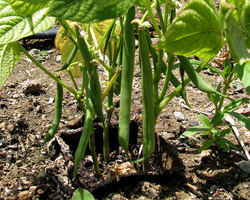How to Grow and Care for Garden Beans
 Bush Green Beans
Bush Green Beans
Growing beans in your home garden provides you with tender young pods suitable for eating right from the vine or for cooking and serving as a side dish. These easy-to-grow vegetables germinate quickly in warm soil and produce a crop of fresh beans by early summer.
Location: Beans are sun-loving plants that prefer 6 to 8 hours of direct sunlight a day. In hot dry areas, some shade at midday is preferred, as excessive heat may cause blossom or pod drop. In northern climates, beans thrive in all day sun.
Soil: Beans prefer rich well-drained soil. Amend with well-rotted manure or compost before planting working the organic matter into the top six inches of soil. This improves the texture of the soil, promoting good drainage and improving aeration necessary for healthy growth.
Fertilizer: Apply 5-10-10 fertilizer, following the recommended application rate on the container, in the spring before planting. Work the fertilizer into the soil with a garden hoe, as contact with seeds or young roots will damage the plants.
Planting: Sow bean seeds in the spring once all danger of frost has passed in your area and soil temperatures are at least 50 degrees F. Seeds planted in soil below 50 degrees will likely rot in the soil before germinating. Plant seeds to a depth of one inch, spaced two to four inches apart. Allow 24 to 36 inches between rows for ease of cultivation and harvesting.
Weed Control: Mulch with organic material such as grass clippings or straw to control weeds, if preferred. Otherwise, hand pull or hoe weeds to keep them under control.
Watering: Water beans deeply once or twice a week or whenever it the soil feels dry one inch below the surface. Use special care to keep soil evenly moist from the time the first buds appear until beans reach maturity. A lack of water at this time reduces overall production and the quality of the beans.
Harvesting: Pick beans when they are long and slender, before the beans fill out inside the pods.
Green, purple and wax beans mature at approximately the same time - depending on the specific cultivar - while pole beans mature several weeks later. Bush beans grow to heights of 12 to 24 inches and do not require a trellis or fence. Pole beans, however, can be trained to twine a "pole," grown on a trellis or used to create a teepee. Whichever you choose to grow, basic cultivation is the same.